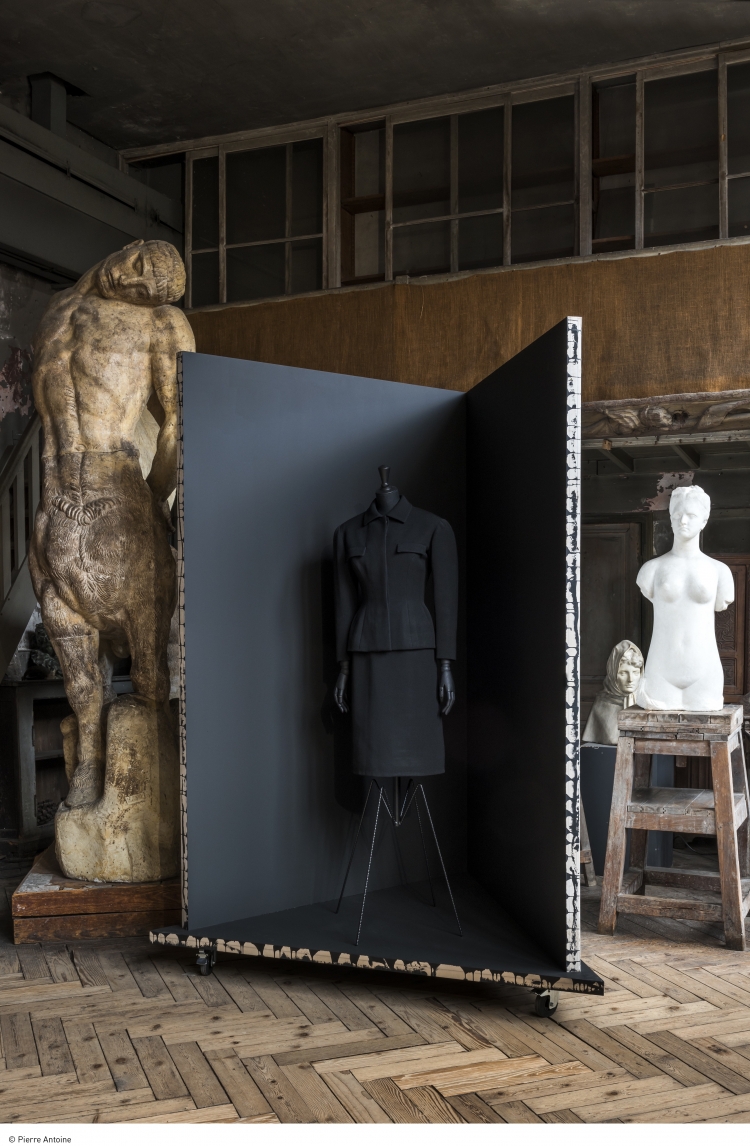Balenciaga, L'œuvre au Noir

A new retrospective exhibition on the works of Cristóbal Balenciaga in the 1950s and 60s has opened at Musée Bourdelle in the 15th arrondissement. The exhibition is part of a series of exhibitions arranged by Palais Galliera highlighting Spanish fashion, with a focus on the spectrum of color, from darker to lighter. Balenciaga, L'œuvre au noir, the first of the series, is an exploration of Balenciaga's intimate relationship with black and the endless possibilities the color created for him as a couturier. The collection of clothing exhibited is set against the sculptures of 19th and 20th century sculptor Antoine Bourdelle, which makes for a majestic performance for the eyes. Both couture and sculpture respectively try to achieve harmony through proportions, movements, and the choice of materials. The juxtaposition of these two art forms was flawlessly achieved by Véronique Belloir—the curator of haute-couture collections for Palais Galliera.
Cristóbal Balenciaga, a Spanish haute couture designer, was known during his prime as "The King of Fashion," He opened his first couture house on Avenue George V in Paris in 1937, but it wasn't until 1951 that his inventiveness really gained prominence. His experience in tailoring from an early age gave him an advantage, compared to other designers emerging at the same time, as he could perfectly take an idea from sketch to creation. He took an important part in reshaping the silhouette of women's clothing, and was seen as a protagonist of the fashion world. When Balenciaga passed away in 1972, the headline of Women's Wear Daily read, "The King is Dead."
"A couturier in the truest sense of the word… The others are simply fashion designers."
- Coco Chanel
The museum itself is made up of individual rooms, each with its own private entrance, with gardens in between. The first part of the exhibition is an ongoing discovery from room to room, leading the viewer to uncover pieces of Balenciaga's clothing nestled between the grandeur of Bourdelle's sculptures. The clothes take on a life of their own, which was clearly Balenciaga's goal—he is quoted as saying, "a woman has no need to be perfect or even beautiful to wear my dresses. The dress will do all that for her." The silhouette, seam, draping, and texture choices found in Balenciaga's work is that of someone truly clairvoyant of the female form. Balenciaga understands the female shape like no other couturier, and every piece of his could enhance any possible bearer.
"Almost since the first day he launched his salon in 1937 he has been acclaimed as the great leader in fashion; what Balenciaga does today, other designers will do tomorrow, or next year, by which time he will have moved on again."
- Vogue, 1962
Although the exhibition focuses on black and how it works fabulously with any fabric or texture, Balenciaga occasionally incorporated small hints of color into his black creations. He was particularly fond of pink—specifically, soft pink—as featured above. Other colors that were included in the pieces were white, red, hot pink, gold, and green; however, there are only two dresses in the whole collection featured that have colors other than black as the main color.
In the second part of the exhibition, the audience is led underground. The walls are painted in moody grey tones that create a mysterious, yet glamorous setting. The audience is informed that some of the pieces have been borrowed from private owners. They have not included any specifics regarding the owners; an ultimately apt decision, as it allows the imagination come up with a possible image of what this person might be like, based on the piece. The rest of the pieces are borrowed from Balenciaga's private archives.
The collection comprises various forms of clothing, both from winter and summer season—jackets, skirts, a bolero, coats, suits, and evening and cocktail dresses. There is also a small collection of accessories, such as hats and jewelry. The exhibition is foremost an explosion of textures and materials, ranging from silk, taffeta, lace, velvet, feathers, pearls, white fur and sequins. To make a long story short, Balenciaga truly made black exciting and unique. Catch the exhibition until July 16 at the Musée Bourdelle, rue Antoine Bourdelle, 75015.










